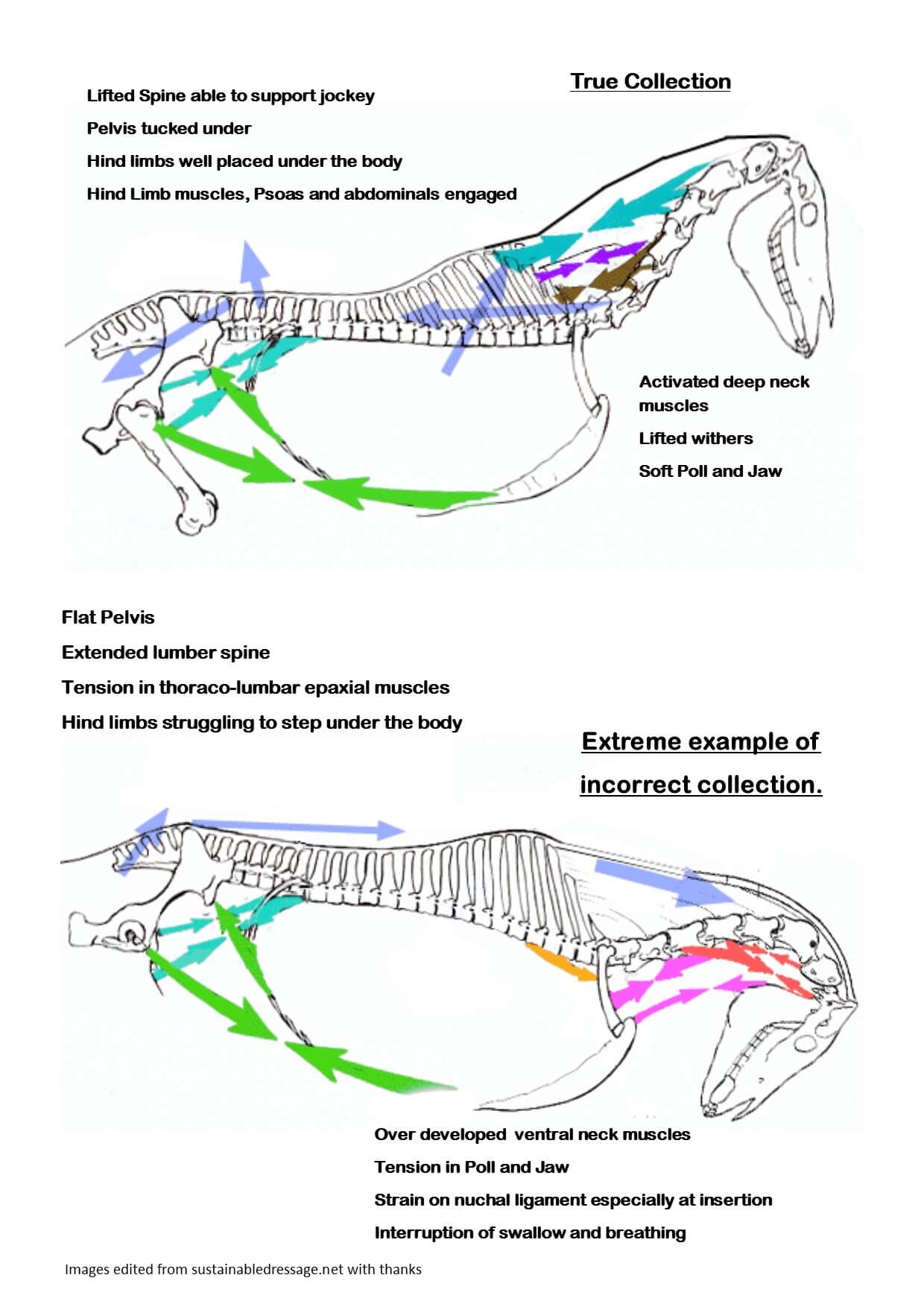The horse distributes his weight 60% over the forelimbs and 40% over the hind limbs predominately due to the weight of the head and neck. Interestingly their anatomy differs to ours in that the scapula is not connected to the thorax via a collar bone. Instead it is only connected via muscle and tendon that form a ‘sling’ in which the upper body is supported. This adaptation allows for a free moving scapula and extreme range of movement of the shoulder and fore limb.
In true collection, the horse is required to shift his centre of gravity to the hind limbs, which should be well placed under the body. In doing so the pelvis is tucked under, the spine raises and the horse has the freedom to ‘lift’ through the withers and out of the base of the neck. The deep neck muscles that carry out this action allow the superficial neck muscles, from withers to poll, to relax a fraction allowing the nose to drop to the vertical. In this instance, the spinous processes separate reducing the risk of impingement whilst allowing the small multifidus muscle that stabilise the spine to build. The core stabilising muscles such as abdominals, psoas and gluteals can also develop to further support distal limbs and the spinal column.
Imposing a contact through the reins or false collection can cause the horse to ‘place his head’ where he thinks it should be. This then creates tension in the jaw, poll or neck and produces an outline that hinges at the 2nd or 3rd cervical vertebra. With the hind limbs not correctly engaged and trailing behind he will find it almost impossible to raise his back from a hollow posture. Over time this can place stress on the long back muscles and on the spinal vertebra. This dysfunction can impact upon and placed increase stress on the hind or forelimbs as he attempts to shift his weight away from the discomfort in his back.
Other factors to consider;
-Saddle fit. Is his saddle in some way causing discomfort or blocking movement?
-Is there an underlying lameness that is causing poor performance and limiting his ability to collect? It is often a chicken and egg scenario. Does the hind limb cause back pain or, as described above, does the back pain cause the lameness?
-Are you sitting equally in the saddle? Is more weight going through one seat bone than another? Is one hand heavier than the other? Are you strong enough in YOUR core that you sit lightly and interfere with his movement as little as possible?
-Is he happy in his mouth? Has he had his teeth checked recently? Is the bit correct for him? Can you re-evaluate and remove excess equipment such as a flash etc. Bridle fit can often be overlooked! Evidence suggests even a nose band done up too tight can reduce hind limb stride length.
Bradfords Veterinary Physiotherapists are well equipped to help guide you through this mine field. We pay great attention to detail ensuring that nothing is missed, in this way you ensure the health and wellbeing of your horse and safe guard his musculoskeletal health of the future.
Please call 01432890490 or email info@bradfordsvetphysio.co.uk to book.
Search
Recent Articles
- The Good, The Bad and The Ugly of Coaching
- Does your horse need more energy, especially when competing?
- Grade 1 International Para Dressage Rider Di Green- Why Lexi Needed a Year Off
- Louise Blanch – Driving Towards New Horizons with the Continued Support of the Para Equestrian Foundation.
- Kissing Spine – Prevention or Cure?
Categories
- Advice Hub
- Athlete
- Carriage Driving
- Dentistry
- Dressage
- Endurance
- Eventing
- Farrier
- Featured
- Featured Horse Ads
- Featured Posts
- Horse Racing
- Horse's Mouth
- Horseball
- Hunting
- Le Trec
- Leisure Riders
- Mounted Games
- Nutrition
- Polo
- Polocrosse
- Reining
- Rescue & Rehabilitation
- Show Jumping
- Showing
- Tack Room
- Team Chasing
- The Pony Club
- Therapy
- Training
- Vaulting
- Veterinary





